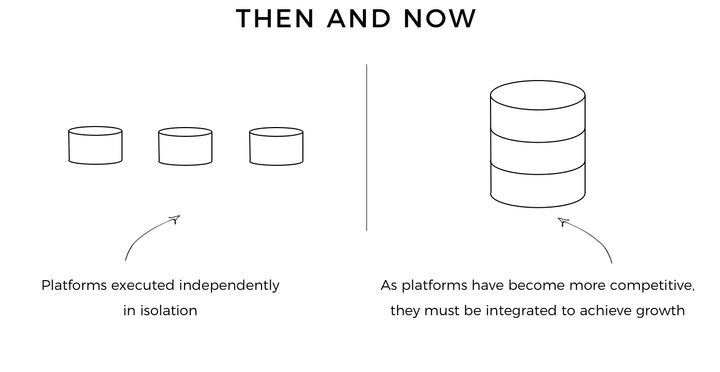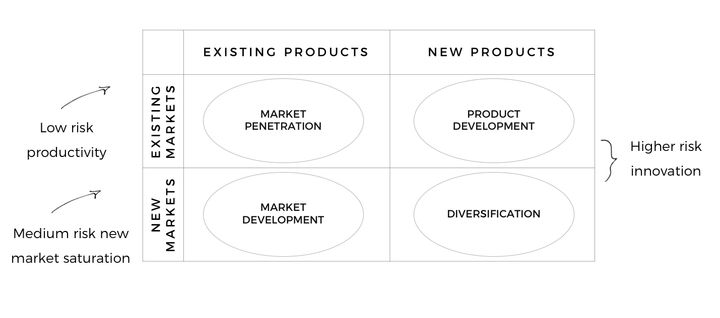
Investing in a diversified portfolio. It's not a new concept to most of us. We manage our investment risk by spreading it across a number of initiatives that have a varying rate of return.
In the world of digital marketing, where algorithms are constantly being tweaked and new platform features are released on the daily, it can be easy to get distracted by the "next shiny thing" and pin our hopes to "silver bullet" tactics.
One of the biggest mistakes I see organisations make is not capping these high growth, high risk investment activities as they get distracted by new shiny feature changes and technological advances that become available. I see organisations do this, usually without realising that they've engaged with a choice to take away valuable time and budget from their long term, slow burn, but high performing optimisation activities.
Many would agree that researching the latest interior design trends is often more fun than organising and maintaining the plumbing for the new kitchen, but in setting out a plan and calling the plumber first, we can make the most of our time and budget. We can focus on the future while work is being done to set the foundation.
Sounds simple enough. So why aren't more companies doing it?
Let's take a trip down memory lane...

Figure 1.
As digital marketing first started gaining traction as a group of platforms, organisations were quick to jump on them and execute through a "test and learn" approach.
Up until a few years ago, the growth of digital was focused on businesses working to quickly harness the power of new digital platforms as they became available. The game was to get in and figure things out as quickly as possible to gain first mover advantage and acquire platform and sector specific knowledge faster than competitors could to effectively compete.
This meant that platforms were often executed in silos, independently and in isolation from one another, often through a combination of in-house and outsourced resources.
For many organisations, this independent platform optimisation resulted in significant growth and was a viable strategy at that time. As time went on though, organisations invested more to maintain the same level of competitiveness and growth stagnated. As digital became a more and more popular marketing strategy, platforms became more competitive and saturated.
Now, even with the most talented digital marketing platform specialists, the opportunity for growth on an independent platform by platform basis is largely capped.
For some time now, the only way to tap into a new level of growth is to reset the foundation based on a clearly focused and unified integrated digital strategy.
Integrated Digital Strategy: A great buzzword, but what does that mean?

Figure 2.
An integrated digital strategy aligns tactical digital execution with what the business actually needs based on where it is in its lifecycle and what challenges it's facing. It also allows for greater efficiency of execution while future-proofing the business' ability to expand and scale up investment as incremental returns are generated.
So basically, it works by:
- Spending money only where money needs to be spent based on what the business needs right now
- Generating returns and reinvesting those returns in the expansion of the strategy
It sounds simple, but it can really only be achieved when looking at all platforms holistically and when they are aligned and weighted to the business goals.
Platform specialists are extremely valuable (imperative, really) to executing the most efficient and effective platform strategy however without an understanding of how their platform contributes to the wider business and marketing goals (and without a digital marketing manager who keeps them accountable to this strategy) spend will very likely be weighted incorrectly.
It is only with a top level understanding of how each platform has the capability to contribute to achieving the wider business goals and through classifying the investment risk, that the greatest level of success can be achieved.
Investment In Action:
Enter: The Good Old Ansoff Matrix

Figure 3.
Many would remember this little matrix from our marketing studies. I find it's a simple way to classify the distribution and weighting of resources.
The matrix can be used to "reverse engineer" the weighted contribution of platforms against the business goals (see Figure 4 below).

Figure 4.
Let's use search as our platform example.
Let's say that the business (as businesses commonly do) sets a growth target percentage for the year.
Subsequently, the marketing department would develop a number of goals to contribute to this growth target. For example, the Head of Marketing might recommend initiating a competitor poaching strategy to further saturate the existing market. This would include a number of marketing tactics, from perhaps a new brand tagline or positioning piece through to a number of digital marketing tactics.
From a search marketing perspective, the company's PPC specialist may determine the percentage of the existing campaigns that have been built to target competitor terms and map the cost of bidding on high performing keywords where the average ad position is generally higher than competitors. From this, a maintenance spend figure can be calculated.
Then to have search contribute to the growth target, additional budget and opportunities in this space can be investigated and forecasted accordingly. This in turn, ensures the most efficient use of spend while maintaining the diversified investment for ongoing maintenance and incremental growth.
Investment Distribution:
The combination of the platform weighting and distribution of the investment should guide the development of the digital strategy as a whole.

Figure 5.
Fundamentally however (as Figure 2 highlights) the core of any digital strategy should be to continue to invest and optimise owned assets that exist on owned real estate. This includes any investment that contributes to the development of content, website or data acquisition (email addresses, remarketing list builds etc.).
Businesses that lack a clearly focused, integrated strategy often do find themselves investing in these three areas however do not do so in a way that balances long term growth with short term focused activities.
What is most common, is an ongoing investment in "Bread & Butter Maintenance" activity and "Short Term Campaign Investment" with some indirect and unfocused execution of "Long Term Assets" as a byproduct of the investment other activities. It is often not given adequate focus.
Balancing digital marketing investment into these three areas, with a considered focus on the investment of owned assets serves two core purposes:
- Ongoing, strategic optimisation requires fewer resources and generates a significantly higher return when compared to developing and executing new initiatives.
- It allows the vast majority of "rented" and short term campaign activity to be underpinned by owned assets which allows an organisation to pick up on any residual engagement or impact of an otherwise "short term only" focused investment (thereby increasing the potential for improved returns).
Investment in long term assets doesn't need to be time consuming or painful and can be slowly built up over time when a renewed focus on day to day execution is adopted. It merely requires an understanding of the return and a commitment to tweaking the internal processes to align with the new strategy.
Why go to the effort?
While in abstract, it may sound daunting to tear down your old kitchen (which I'm sure served you for many years and many would argue "Still works just fine by the way!"), this form of investment in digital activity is superior to "flying by the seat of our pants" on what's "new and shiny" in the digital world. It allows for improved management of platform specialists and execution (in-house or agency) and provides them with the transparency and understanding of how they are contributing to the bottom line.
Let's engage with the choice. Set the foundation of our strategy to maintain a level of performance and establish the latitude to "test and learn" as new technology and platform changes arise.
If you're mapping a move from a silo based execution approach to an integrated digital strategy, I know this sounds daunting. It can't be executed overnight but by first improving the performance of ongoing maintenance activity, the risk can be managed and organisations seek only to gain from the opportunity to consolidate, optimise and improve their overall return on investment.
It's not the "shiny new thing" that you'll get "oooos" and "ahhhs" in the boardroom for, but it will generate significant value for your business and allow you to have the budget and freedom to chase after innovative and disruptive concepts once your foundation is generating you a significant return and you're smashing your targets. Let's stop pinning our hopes only to an "innovative and disruptive" silver bullet, and start thinking like strategic digital marketers.
